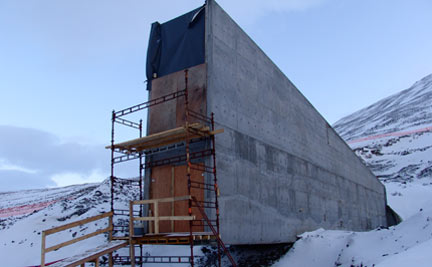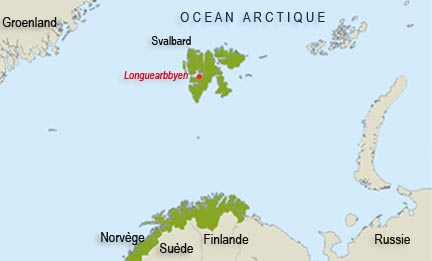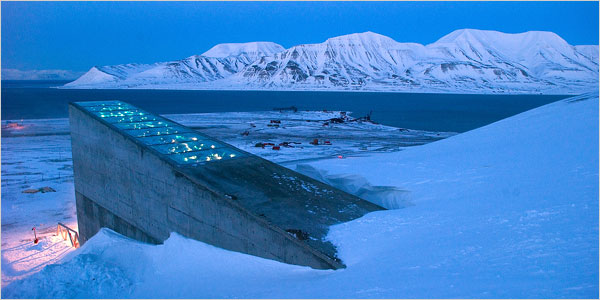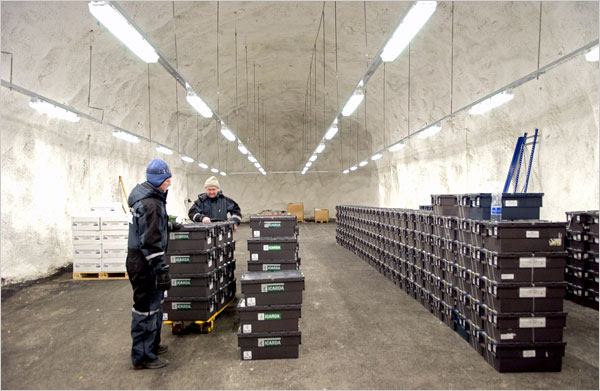|
|
 |
 |
 |
|
D'après l'article diffusé par
Radio France internationale
Le grenier à graines du monde
d'après Marion Urban, 25/02/2008
Le Dépôt international pour les graines ouvre ses portes ce 26 février au Svalbard, un archipel d'îles norvégiennes situé dans le cercle arctique. Creusées dans le permafrost à flanc de montagne, les chambres fortes de cette banque mondiale accueillent un premier contingent de semences venues d'Afrique, des Amériques, d'Asie et d'Europe. Au final, c'est près de 3 millions de variétés de graines qui seront hébergées sous forme congelée.

Dans la montagne gelée, les graines du monde.
(Photo : Mari Tefre/ GCDT)
| |
À partir de ce 26 février 2008, le Dépôt international pour les graines de Svalbard en Norvège, constituera la réserve ultime des semences sur notre planète, quand toutes les autres banques auront été détruites ou épuisées.
Construite et financée par le gouvernement norvégien associé à la Banque nordique de gènes et le Fonds fiduciaire mondial pour la diversité des cultures ( The Global Crop Diversity Trust), elle accueillera des échantillons de toutes les semences qui supportent la congélation entre -4° et -12° C.
Les banques de graines du Nigeria, du Bénin, d'Afrique du Sud, du Canada, du Mexique, de Colombie, de Syrie, de l'Inde, des Philippines et de près de 80 pays ont transféré une première collection de 300 000 variétés de graines à l'occasion de l'inauguration des bâtiments du Dépôt international de Svalbard. Du blé, du maïs, du riz, de l'orge des pois, du sorgho, des fèves, des arachides, des haricots emballés dans des sachets aluminium scellés.

Localisation géographique
| |

The entrance of the Global Seed Vault near Longyearbyen on the Norwegian island of Svalbard sits halfway up a mountain overlooking the main airport and fjord near the island's capital.
Photo: Dean C.K. Cox for the International Herald Tribune
| |

The Global Seed Vault began receiving millions of seeds in boxes that workers moved into different chambers as they began the storage process on Svalbard. What started out as independent efforts from seed banks around the world is now being consolidated and systematized.
Photo: Dean C.K. Cox for the International Herald Tribune
| |
Au cas où ...
À la fin des années 80, des terroristes péruviens ont détruit une banque internationale de semences de pommes de terre dans les Andes, assimilant ses fonctions à celles des laboratoires privés du génie génétique.
En 2003, la banque de semences de Abu Ghraib en Irak, a été pillée et a perdu définitivement des variétés de blé et de lentilles séculaires. Celle d'Afghanistan a connu la même mésaventure.
En 2004, le tsunami asiatique a emporté le grenier de semences de riz de la région et deux ans plus tard, le typhon Xangsane a détruit une partie des réserves des Philippines. En 1998, c'étaient les graines d'haricots du Honduras et du Nicaragua qui ont disparu dans l'ouragan Mitch.
S'il n'y avait pas eu de banques de graines du réseau du Groupe consultatif pour la recherche agricole internationale et d'autres institutions similaires, ces pays auraient perdu à tout jamais leurs semences.
Pour être stockées à Svalbard, les graines doivent déjà faire partie des collections de deux autres banques de semences dans le monde. Les sachets de graines seront placés sur des étagères dans les trois chambres fortes, au fond du tunnel creusé dans la roche.
Le Dépôt sera placé sous surveillance permanente.
Les graines n'étant pas immortelles, une partie de l'argent consacré au Dépôt international ira financer des projets de régénérescence des semences dans les pays en développement.
Il existe près de 1 400 banques de graines dans le monde.
Emile Frison, directeur général de Bioversity international, explique le choix de Svalbard.
écouter - 1 min 50 sec
22/02/2008 par Marion Urban
L'approvisionnement du Dépôt international pour les graines expliqué par Emile Frison, directeur général de Bioversity International,
écouter - 0 min 40 sec
22/02/2008 par Marion Urban
Autres échos
Business View: The world wheat crisis and a Noah's Ark of seeds
Independent.co.uk
Margareta Pagano, Business Editor
Sunday, 2 March 2008
The present wheat crisis reminded me of the first time I met Professor Cary Fowler. It was over supper at one of the three restaurants on the Arctic island of Svalbard and we were debating if we dared try the whale steak. Neither of us was brave enough, choosing instead beefburger and chips. Over dinner, the professor, the world's authority on crops, explained why he had spent the past 20 years badgering governments about the need for a single safe storage place for all the seeds on the planet which give us our food.
Professor Fowler said that while most countries have seed banks for their indigenous crops, many seeds were being lost. That was because they were either becoming extinct or casualties of war, as with the case of the Iraqi seed bank, or just going missing through ineptitude – thieves looted the seed bank in Zambia thinking it was a money bank. The US crop geneticist was so worried that the world could be losing its most basic resource that he came up with the idea of an international vault where duplicates of the 100 million or so of the world's crop species could be guarded. A Noah's Ark, if you will, holding all the seeds needed to restart the world should our food supplies be wiped out by nuclear war or mankind's other idiocies.
As head of the Rome-based Global Crops Diversity Trust, Professor Fowler spent years persuading governments to agree to share their seeds with each other. But this wasn't easy as so many countries were frightened of giving away such precious resources – as precious to some as metals such as gold.
But he won his battle, getting international agreement in June 2006, which is when we met on the wild Arctic island to celebrate. It was the oddest occasion: a stone-laying ceremony on a windy hill on the site of the new vault, with a few lucky reporters mingling with the prime ministers of Norway, which funds the vault, Sweden, Denmark, Finland and Iceland. The PMs had flown in by private jet on their way to a nearby Nordic council meeting. Professor Fowler recommended the island because of its icy remoteness: it's the most northerly inhabited place in the world, some 500 miles from the North Pole. Being there is like standing on the edge of the planet. Not somewhere terrorists are likely to seek out.
To show what this Doomsday vault might look like, Fowler took us to see the Nordic Seed Bank already on Svalbard, buried deep in an old coal mine where the permafrost keeps the rock frozen. Locked away inside a disused shaft was a giant black container in which the 32,000 seeds of all the crops now growing in the Nordic countries are kept. Here the seeds will stay fresh for thousands, if not millions, of years.
Then his visions for his international safety box seemed worthy, romantic even, if not a little far-fetched. Now, with today's chronic food shortages and soaring wheat prices, he looks smart.
Drought over the past two years in Australia, and erratic US weather, have led to the greatest shortage of wheat in decades. Meanwhile, the decision by American farmers, the world's biggest wheat exporters, to grow crops for biofuels, backed by heavy subsidies, has prompted them to switch to corn and soya. US wheat inventories are down to their lowest since 1946, with enough stocks to cover just 12 per cent of consumption.
There are bigger problems. Water shortages – 70 per cent of the world's water is used for farming – and changing weather patterns due to global warming are affecting the sorts of plants that can be grown. Some 100,000 species are close to extinction because so many developing countries are not protecting their seed collections and because of the return of the deadly wheat stem rust, a disease known since Roman times, which has now spread to Iran.
Speaking to Professor Fowler again on Friday, back in Rome after the formal opening of the Svalbard Global Seed Vault, he is more worried about food supplies than last time we spoke, warning of a "perfect storm". There are only two ways to improve food production, he says: reclaiming more land and higher yields. He says the latter is the most vital – one of the reasons he is working with climatologists and geneticists to look at crop varieties that can withstand the new weather patterns emerging from global warming.
It was the 1970 food shortages that stirred him to embark on his mission to save diverse crops. Then it was caused by what seemed a trivial matter – anchovy shortages in South America. Cattle farmers, who had been feeding their animals the fish switched to wheat, causing prices to soar and leading to starvation in Africa. As he warns, there is a domino effect to everything we do.
New York Times - 29 February 2008
Near Arctic, Seed Vault Is a Fort Knox of Food
read more =>
La Voie Agricole -Canada - 26 February 2008
Une réserve à toute épreuve pour la génétique agricole
read more =>
Haut de page
|
|
|





